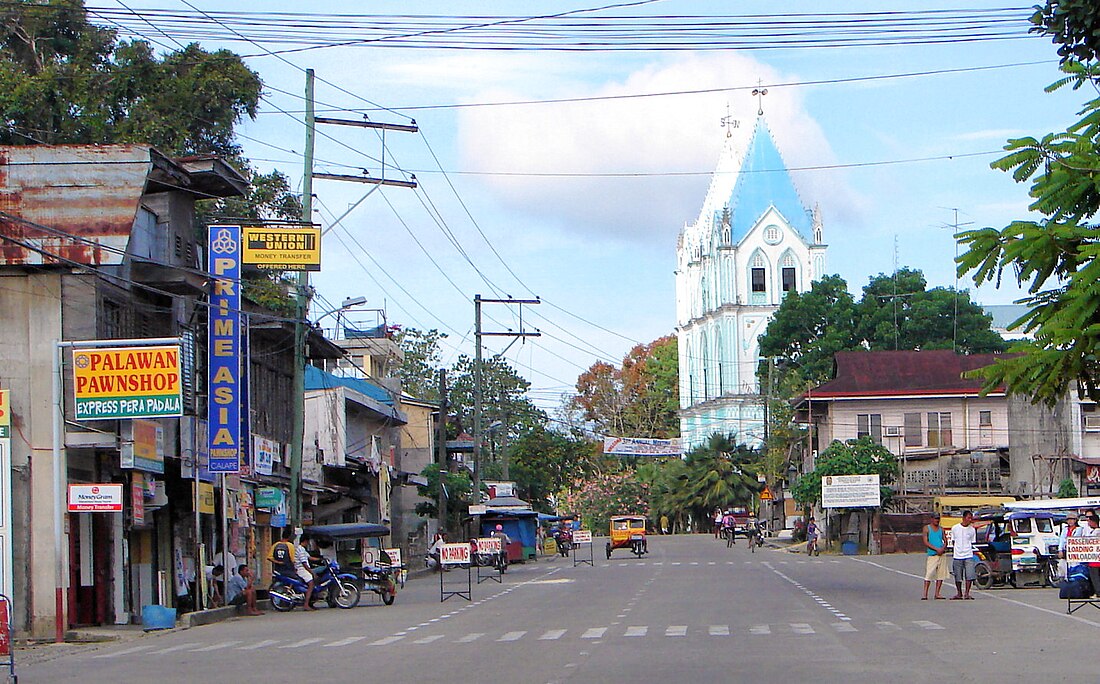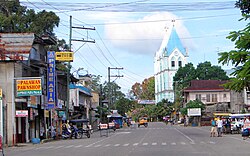Top Qs
Timeline
Chat
Perspective
Calape
Municipality in Bohol, Philippines From Wikipedia, the free encyclopedia
Remove ads
Calape, officially the Municipality of Calape (Cebuano: Lungsod sa Calape; Tagalog: Bayan ng Calape), is a municipality in the province of Bohol, Philippines. According to the 2020 census, it has a population of 33,079 people.[7]
Remove ads
Etymology

Its name is historically linked to kalapi,[9] a type of rattan once abundant in the area, or is believed to signify a traditional gathering place for traders and fishermen.
History
By the time Spaniards arrived, there was already a native settlement in Calape. In 1802, the Spanish governor of Cebu established it as an independent municipality.
In 1957, the barangay of Abucayan Norte was created from the sitios of Cabulihan and Cabinong, and the barangay of Abucayan Sur from the sitios of Rama and Bino. The sitios of Binogawan, Masonoy, Bentig, Cahayag, and Lawis were also constituted into barrios.
Remove ads
Geography
Summarize
Perspective
Calape is bounded by Loon in the west and Tubigon in the east. To the north, the town center faces the Cebu Strait on the western side of Bohol Island, 42 kilometres (26 mi) from Tagbilaran. The jurisdiction of Calape includes the islands of Pangangan (eight barangays) and Mantatao, as well as two uninhabited islets, Poom Island and Basihan Island.
There are four rivers that flow through the territory: Tultugan and Liboron Rivers that drain into Calape Bay, and Calunasan and Abucayan Norte Rivers that drain into Tipcan Bay.
Most of the coastal area is a fairly level plain that gradually rises into rolling hills of coralline limestone. The highest point in Calape is Mount Candungao in the eastern portion of the town, with an elevation of 150 metres (500 ft) above sea level.[10]
Barangays
Calape is politically subdivided into 33 barangays. Each barangay consists of puroks and some have sitios.
There are 18 barangays which form part of coastal area.
Climate
Remove ads
Demographics
Religion
92% of Calape's population is Roman Catholic. The remaining 8% is divided among other religious groups.
Remove ads
Economy
Poverty incidence of Calape
10
20
30
40
50
2000
40.11
40.11
2003
25.17
25.17
2006
39.90
39.90
2009
40.41
40.41
2012
25.42
25.42
2015
22.70
22.70
2018
17.40
17.40
2021
22.25
22.25
Source: Philippine Statistics Authority[18][19][20][21][22][23][24][25]
Education
Summarize
Perspective
Calape boasts a high literacy rate, with 93.09% of its population being literate as of a 2007 survey.
Public Schools
Elementary Education
- Banlasan Elementary School
- Bentig-Calunasan Elementary School
- Bonbon-Catmonan Elementary School
- Cabayugan Elementary School
- Cabudburan Elementary School
- Calape Central Elementary School
- Camias Elementary School
- Canguha Elementary School
- Kinabag-an Elementary School
- Labuon Elementary School
- Mandaug Elementary School
- Mandaug-Gamay Elementary School
- Mantatao Elementary School
- Pangangan Elementary School
- Sampoangon Elementary School
- San Isidro Elementary School
- Tinibgan Elementary School
- Tultugan Elementary School
- Ulbujan Elementary School
Secondary Education
- Calape National High School
- Fermin Tayabas National High School
- Mayor Anunciacion R. Tuazon National School of Fisheries
- Pangangan National High School
Higher Education
- Bohol Island State University
- Program offerings[26]
- College of Teacher Education
- Bachelor of Elementary Education
- Bachelor of Secondary Education major in English
- Bachelor of Secondary Education major in Mathematics
- College of Technology
- Bachelor of Science in Computer Science
- Bachelor of Science in Industrial Technology major in Food Preparation and Services Technology
- Bachelor of Science in Industrial Technology major in Electrical Technology
- College of Midwifery
- Bachelor of Science in Midwifery
- College of Fisheries
- Bachelor of Science in Fisheries
- College of Teacher Education
- Program offerings[26]
Private Schools
- Calape Baptist Mission School, Inc.
- St. Teresa's School of Valladolid, Inc.
Remove ads
Government
Summarize
Perspective
During the Spanish colonial period in the Philippines, the chief executive of a town was known as the Capitan Municipal. This title later evolved into Presidente Municipal (English: Municipal President) during the early American regime. Eventually, the title Municipal Mayor became standard, especially during the Commonwealth period and onward. During wartime or transitional governments, such as under Japanese occupation or post-liberation, the term Mayor was commonly used for town chief executives, sometimes appointed by military or provisional authorities.
In earlier times, the selection of town leaders sometimes involved a drawing of lots (sortition) among prominent individuals from the principalia class—those with significant landholdings, formal education, and Spanish literacy. However, the exact sequence of tenure for these early town executives is often undocumented or difficult to reconstruct due to limited archival records.
Regular elections for this position were introduced under the American colonial administration through the Municipal Code (Act No. 82 of 1901),[27] with elections initially held every three years. This three-year term remains in effect for municipal mayors under the Local Government Code of 1991 (Republic Act No. 7160).[28]
Following the EDSA People Power Revolution in 1986, elected local officials were removed from office and replaced by Officers-in-Charge (OICs) appointed by the new government. This transitional arrangement remained in place until regular local elections resumed in 1988.
List of chief executives
- Mauricio T. Cuario (1923–1927)[29]
- Benigno Palacio (1933–1937)[30]
- Felomeno Ruiz (1938–1941)[31]
- Gaudencio Sepe (1942–1945)
- Pedro Dumadag (1946–1951)
- Ramon E. Nazareno (1952–1955)
- Alberto Carlon (1956–1963)
- Arsenio G. Damalerio (1964–1967)[32]
- Isidro R. Redulla (1968–1979)[33]
- Anunciacion R. Tuazon (1979–1986)[34]
- Gabriel P. de la Peña (1986–1987)[35]
- Gerardo T. Yu (1992–1995)[36]
- Julius Caesar Herrera (1995-2001)[37]
- Ernesto Cuico Herrera II (2001–2007)[38]
- Nelson Nesia Yu (2016–2022)
- Julius Caesar Herrera (2022–2025)
Remove ads
Gallery
- Calape Public Market
- Calape Central Elementary School
Notable personalities
- Yoyoy Villame, a novelty singer
- Ernesto Falar Herrera, Senator of the Philippines (1987–1998) and former congressman of Bohol's 1st district (1998–2001); a legislator in the 8th, 9th, 10th and 11th Congresses.
References
External links
Wikiwand - on
Seamless Wikipedia browsing. On steroids.
Remove ads









